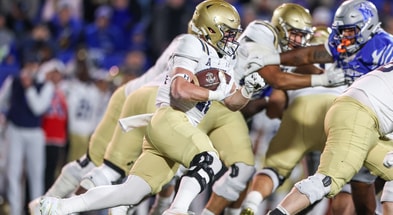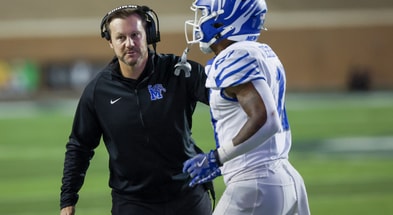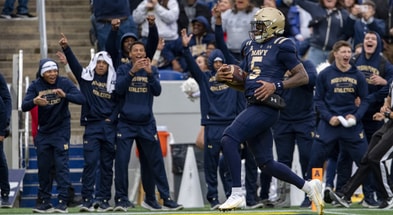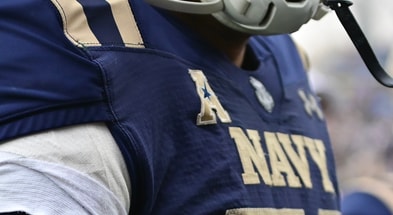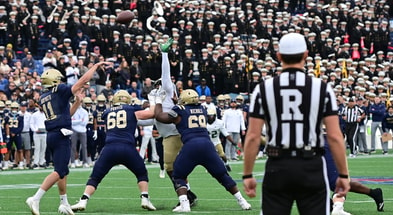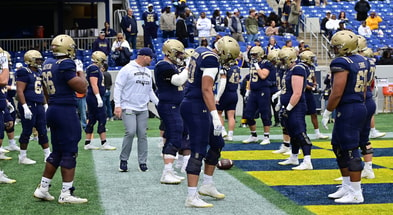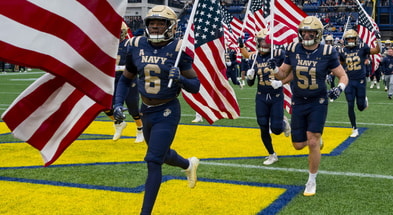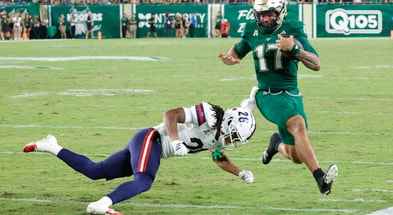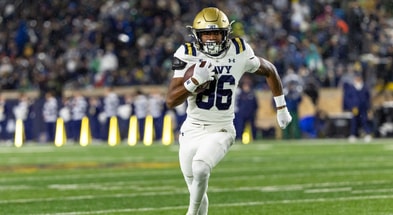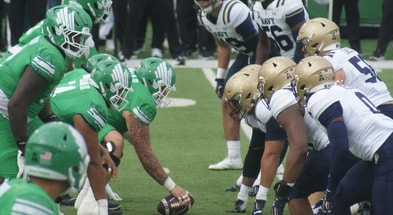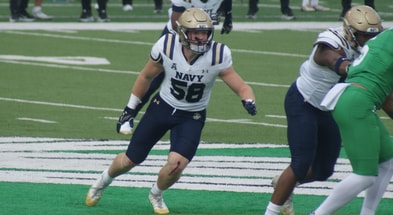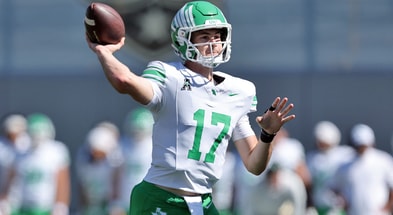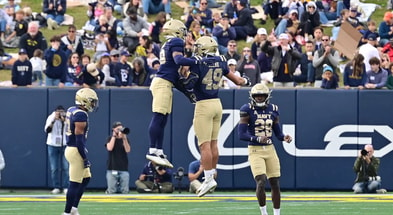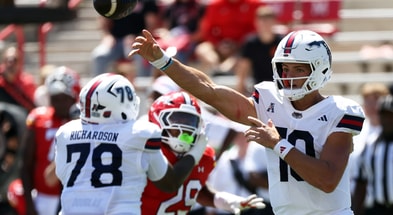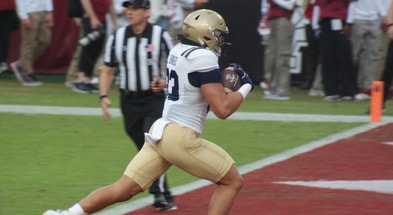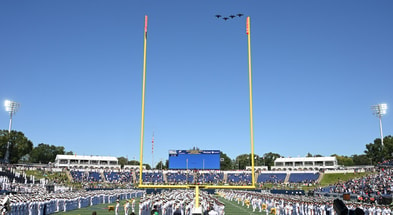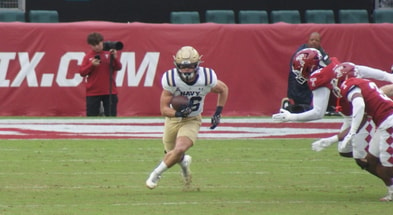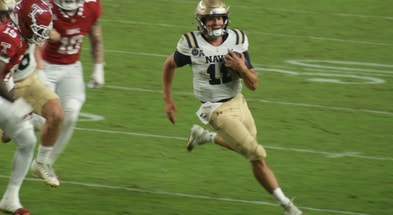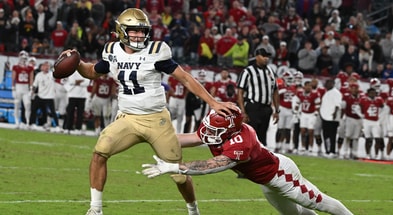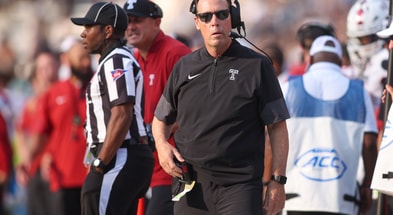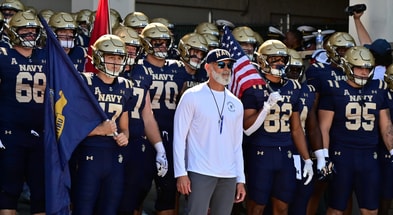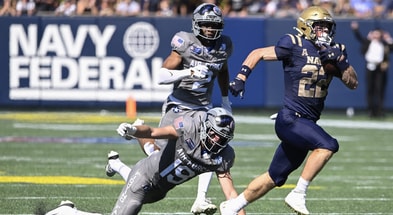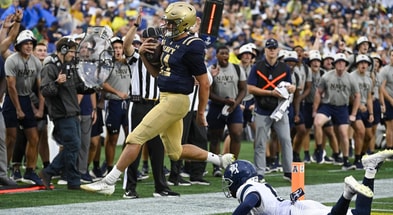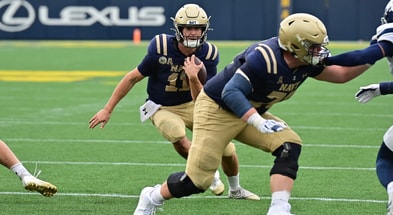The Air Force Debrief
In their Zoom calls with the media during the week, Navy’s coaches were all very clear that they did not care about Air Force‘s 1-3 record. They knew that Saturday’s game would be a dogfight. I’m not sure if anyone could have expected the instant classic it turned out to be, though.
Blake Horvath threw for 339 yards and three touchdowns while adding another 130 and a score on the ground to lead Navy to a thrilling 34-31 win in Annapolis. His 469 total yards set a school record. Eli Heidenreich was the primary beneficiary of those passing yards, with 243 receiving yards and three touchdowns of his own, also school records. The three touchdown receptions put Heidenreich at 14 for his career, breaking yet another school record. As a team, the Mids had 517 yards of offense, and the 339 passing yards were the fifth-most in school history.
And they needed every bit of that production, because Air Force’s offense was almost as good. They put up 460 yards of total offense, which is roughly their season average. Quarterback Liam Szarka, who just set his own school record for total offense a week earlier, had another stellar day, throwing for 212 yards and running for 152. But it was a mistake in the option game– a batted pitch by Jaxson Campbell as the Falcons were driving near the end of the game– that ultimately sealed Air Force’s fate.
This was not a game of protracted, time-consuming drives. This was a game of haymakers, and both teams dedicated most of their offense to setting up those knockout blows.
We’ll start with Air Force, who came into the game accustomed to needing big plays to stay competitive. Unfortunately, they often received a helping hand from the Navy defense, and it started right from the beginning.
Here’s Air Force’s first play from scrimmage. They ran a play we’re all familiar with, a quarterback counter trey with jet sweep motion in the opposite direction. The defensive line stems to the left, which puts the end in a good position to knock the playside tackle off his path to the inside linebackers. However, he doesn’t really make much contact on the tackle, and it probably wouldn’t have mattered if he did. The ILB and safeties overcommit to the sweep, which leaves a big hole for the QB going the other way.
Later in the drive, the stem is more effective in influencing the PST, and the playside ILB scrapes outside. However, both the ILB and the safety took on the same blocker. One of them (I’m guessing the safety) was wrong, and it left an uncovered gap that the quarterback ran through.
Bad run fits were a problem throughout the game, but the bigger issues were in pass defense. In fairness, Air Force had a little to do with that. Tight end Bruin Fleischmann had been used primarily as a blocker and had only six catches for 43 yards coming into the game. But Air Force made him the focal point of their attack on Saturday, with six catches for 166 yards. Perhaps some of his production can be attributed to the Falcons’ saving him for this game, but most of it was the secondary having their eyes in the wrong place.
On this play, Air Force ran a wheel-post, with Fleischmann on the post. The corner was playing man defense on the post, leaving the safety to cover the wheel. But the quarterback’s rollout put the safety in conflict. He had his eyes in the backfield in case the quarterback decided to run, making him late getting over to cover the tight end.
Later in the drive, Air Force tried to take advantage of this with a two-for-one block on the triple option, but neither the safety nor the cornerback was fooled.
I’m not sure what the wide receiver accomplished on that play.
Air Force found other ways to take advantage of the secondary’s focus on the backfield. On these plays, they fake a swing pass to the running back, and the tight end sets up looking like he’s blocking. The defender takes the bait, and the TE heads upfield. The Mids were lucky the first time, but not so much the second time.
Interestingly, one name that wasn’t mentioned very much was Cade Harris, the Falcons’ leading receiver. It wasn’t for a lack of trying, though. In this play, Harris is put in motion before running a crossing route. The receiver lined up on the other side of the formation also runs a crossing route, while the third receiver runs a go route. Navy has a cornerback blitz on, and the safety lined up on the blitz side picks up that receiver. On the other side, though, both the safety and the cornerback take the go route. Nobody covers Harris, who ends up wide open on the other side of the field. Fortunately for Navy, Justin Ross hit Szarka as he threw, averting disaster.
Not all was bad, though. The game was ultimately decided when Campbell batted Szarka’s option pitch, but that play was set up earlier in the game. When Air Force faced a third and long in the second quarter, they called a triple option play. It seems like a strange play call, but the logic is the same as running the option in the two-minute drill. If the secondary is playing back, expecting a pass, it can set up perimeter runs.
The first time they ran it, the outside linebacker forced Szarka to cut upfield, where he was met by a Navy lineman who beat his block. Facing third and long again in the fourth quarter, Air Force called the same play, in almost the same formation. Again, the playside lineman beat his block, and again, the outside linebacker stepped into Szarka’s path. This time, however, Szarka pitched the ball, likely hoping to avoid a repeat of the last time he ran that play. But he turned upfield as he did so, which put Campbell’s hand right in the path of the ball. Landon Robinson, who had stunted around to the back side of the play, was Johnny-on-the-spot.
During his Zoom call this week, PJ Volker noted that, despite the numerous mistakes made by the defense, their three best plays were actually their last three plays on the field. This wasn’t the defense’s finest hour, but they made the plays they had to make when the team needed it most.
The offense, on the other hand, put on an aerial show that could replace the Blue Angels at graduation.
In a lot of ways, the running game looked like most Navy games as far as playcalling goes. The goal was to get lateral movement from Air Force’s inside linebackers by running outside, then cutting behind those linebackers, or using misdirection and counters. There were a few wrinkles thrown in, though, with the most notable being the shovel pass to Cody Howard.
The first time Navy tried it, they ran it out of a power read look. It appeared similar to a counter trey, but instead of the guard and tackle pulling, it was a guard and the tight end. The jet sweep didn’t do enough to influence the “read,” though, and he came inside to make the tackle. It still picked up a first down.
The second time Navy ran it, they ditched the mesh and had Horvath fake a rollout. This got the defense moving away more, making the pass more effective.
Howard was tripped up by a linebacker behind him, diving at his feet. If not for that, he might have scored. Navy didn’t run this play after the first drive, but I bet we’ll see it again in future games.
The other notable wrinkle Navy used was putting Braxton Woodson in the backfield next to Horvath. In this play, the Mids ran a power read, just like any other. Air Force had an EZ stunt on, and the outside linebacker did a good job knocking the playside tackle off his path to the inside linebacker. But it didn’t make a difference, because the ILB was so focused on Woodson that he immediately scraped outside. That left nobody in the middle of the field when Horvath kept the ball.
The challenge when playing Air Force, though, is blocking them individually, because their technique is almost always some of the best that Navy sees every season. Navy did well against them statistically, averaging 6.1 yards per carry. The problem is that they weren’t really getting six yards at a time. Navy averaged 1.9 yards per carry on first down. Every long run they had was offset by runs of one or two yards. Navy’s average distance to go on third down was 7.8 yards.
This is where I think not having Alex Tecza hurt Navy the most. Jackson Gutierrez is an exciting runner, but he’s a freight train. You aim him at a gap and fire. Tecza can do that, but he also knows how to be patient. He can read interior defenders and make a cut that turns a two-yard gain into a four-yard gain. Navy has big-play ability all over the field, but Tecza adds consistency. There is a considerable difference between 2nd and 8 to go and 2nd and 6.
Fortunately for the Mids, big plays ruled the day, and most of them came in the passing game. They wasted no time getting started either. Navy’s first play from scrimmage was a perfect throw from Horvath and a better-than-perfect catch from Heidenreich for 36 yards.
It was a statement of intent from the Air Force defense. While their secondary has been torn to shreds all season, they made it known right away that they were going to be as aggressive as they always are against Navy. The Falcons rushed their entire front seven, leaving the secondary in one-on-one coverage across the board. Horvath delivered a ball so perfect under pressure that it almost defies belief. The one-handed grab was just rubbing it in.
That was the first of eight catches for Heidenreich, who had a historic day. Air Force just couldn’t figure him out.
On this play, they tried press coverage. Horvath’s play fake drew in the safeties, and after Heidenreich beat his man inside, it was an easy throw for the touchdown.
On this play, they backed off in coverage and left the safeties deep. Heidenreich still beat the corner, and the safety minding the crossing pattern in front of him left him flat-footed. Heidenreich ran past them both for another touchdown.
On Heidenreich’s third touchdown, Air Force ran the same blitz they used on the first play. This time, Horvath rolled out, so he had a little more time. The rollout also caught the attention of the safety, who had his eyes in the backfield in case Horvath decided to run. The safety’s first steps were toward the line of scrimmage, and the moment that happened, he was beaten.
While Heidenreich was the star of the show, his explosive plays were only part of the story. What struck me the most about this game was the confidence Drew Cronic had calling pass plays. The most obvious example was on Navy’s final drive, when they threw to Gutierrez on the fourth and one that ended the game. That wasn’t the only example, though.
Navy ran a few sideline fades, including one in the second quarter and one in the fourth. On both plays, they lined up with trips receivers to the boundary side to isolate the cornerback in single coverage on the field-side receiver. Horvath put both throws right on the money, and both Heidenreich and Nathan Kent channeled their inner Willie Mays on the catch.
Now, these are not high-percentage plays. Fades are popular because they’re unstoppable when executed perfectly, but they’re very hard to execute perfectly. Not only did Navy do so, but look at the situation in both instances. On the first play, an incomplete pass would have left the Mids in 2nd and 15. They needed a score on that drive to keep pace after a fast start for Air Force. On the second play, they would’ve faced 3rd and 7 in a tie game in the fourth quarter. Incomplete passes would’ve put Navy in difficult situations, but Cronic had such confidence in the passing game that he called these plays anyway. I’ve watched Navy football for a long time, and I’ve never seen anything like it.
Navy’s special teams also deserve some recognition for how well they played. Nathan Kirkwood, who is quietly having an outstanding season, drilled both of his field goal attempts. Isaiah Bryant had a 43-yard kick return. Lance Gossett returned to kickoff duties and put the ball in the end zone. Jacob Carlson had two punts: one that went 52 yards, and one that was downed at the six. In a three-point game, special teams can easily be the difference between winning and losing. Navy excelled here.
Both teams had outstanding games throwing the ball, but they achieved their success in different ways. There were one or two plays where Heidenreich was turned loose by the secondary, but for the most part, Navy’s aerial success was due to Horvath’s accuracy and the equally impressive hands of his receivers. Air Force’s success came primarily due to Navy coverage busts. I’m not sure one way is better than the other, but you can be assured that Army will be well aware of Navy’s coverage problems in December.
But that’s a topic for another time. For now, Navy fans can revel in another win. We don’t know where the Commander-in-Chief’s Trophy will be next year. But we know where it won’t be, and that’s a start.
